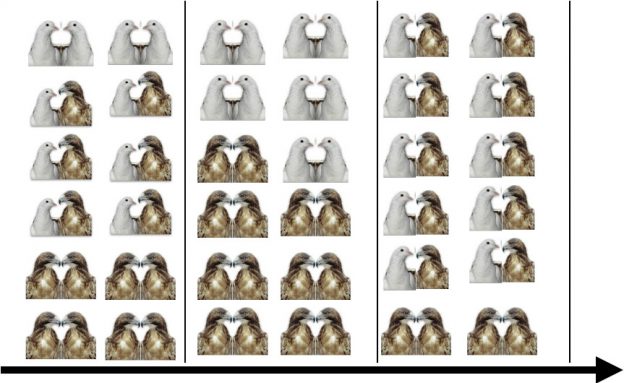The Lotka-Volterra predator-prey model is one of the earliest and, perhaps, the best known example used to explain why predators can indefinitely coexist with their prey. The population cycles resulting from this model are well known. In this article I show how adaptive behavior of prey and predators can destroy these cycles and stabilize population dynamics at an equilibrium. The classical predator-prey model assumes that interaction strength between prey and predators is fixed, which means that coefficients describing interactions between prey and predators do not change in time. However, there is increasing evidence that individuals adjust their activity levels in response to predation risk and availability of resources. For example, a high predation risk due to large predator numbers leads to prey behaviors that make them less vulnerable. They can either move to a refuge or become vigilant. However, such avoidance behaviors usually also decrease animal opportunities to forage which leads to foraging-predation risk trade-off. The present article shows that such a trade-off can have a strong bearing on population dynamics. In fact, while the classical Lotka-Volterra model has isoclines that are straight lines, the foraging-predation risk trade-off leads to prey (predator) isoclines with vertical (horizontal) segments. Rosenzweig and MacArthur in their seminal work on graphical stability analysis of predator-prey models showed that such isoclines have stabilizing effect on population dynamics because they limit maximum possible fluctuations in prey and predator populations. The present article shows that not only population fluctuations are limited, but they can even be completely eliminated.
Tag Archives: Krivan-game

Talk: Why would Darwin love game theory?
Evolutionary game theory was developed as mathematical description of Darwin theory. The talk guides you through basic concepts of evolutionary game theory (the Nash Equilibrium, Evolutionarily Stable Strategy). Using classical models i.e., the Hawk-Dove, the Prisoner’s dilemma, I will explain evolution of aggressivity and evolution of cooperation.

Evolutionary game theory with time constraints
Classic matrix models of evolutionary game theory assume that all interactions between strategies/phenotypes take the same amount of time. Here we are developing a new methodology to study models where interaction times depend on the two interacting strategies. We apply this theory to some classic evolutionary games. E.g., the classic Hawk-Dove game predicts that when interaction cost between two Hawks is low, the only evolutionarily stable strategy is all Hawks. In other words, when cost of aggressiveness is low, all individulas will be aggressive. However, when Hawk-Hawk interactions take long enough time, when compared with duration of other interactions, aggressiveness evolves even when the cost of fighting is low. For the repeated Prisoner’s dilemma, cooperation evolves if individuals opt out against defectors. This means that if a cooperator meets another cooperators, they will stay together as long as possible. However, if a cooperator meets a defector, it will play the game only once and then the pair will disband.